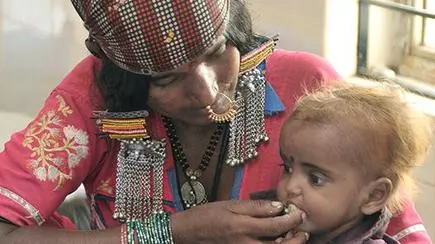 The rise in female malnutrition can be countered by integrating a women-focussed initiative with the National Nutrition Mission
The rise in female malnutrition can be countered by integrating a women-focussed initiative with the National Nutrition Mission
India is home to the largest proportion of malnourished children in the world, with widespread prevalence of stunting, wasting and people being underweight. That said, a more pertinent factor is that malnutrition is the most significant contributor of the under-five mortality in India. According to the United Nations, India has the highest absolute number of under-five and neonatal deaths in the world. Despite its progress in reducing child mortality, the benefits thereof have not been equally shared by the male and female child. In contrast to the global trends, child mortality in India is higher for females than that for males.
India’s under-five mortality rates for males and females, which stand at 38.4 and 40.4 respectively, tell the same story. This shows that girls have a higher probability of dying before attaining the age of five years than boys. Through backward deduction, this means that effects of malnutrition effects are more pronounced for girls than boys. And if that stands, what then explains this anomaly? The root cause of such male-female differentials is the socio-cultural mindset of the people and widespread prevalence of gender discrimination.
Prevalent bias
Understandably, reducing the prevalence of malnutrition among girls holds the key to reducing the burden of female under-five deaths. Research shows that the girl child experiences mistreatment and neglect from the time of birth and thereafter. Jean Drèze and Amartya Sen document that girls are breast-fed for a shorter period of time than boys.
Meanwhile, during early childhood, the girl child faces a disadvantage in accessing nutrition and is thereby exposed to a higher risk of morbidity and mortality. Based on her analysis of differential treatment of girls and boys in North India, Barbara Miller terms the prevailing anti-female bias as ‘extended infanticide.’
Adult female members of the household also tend to be treated as inferior and receive a relatively lower share of nutrition and economic resources. In this context, maternal nutrition has significant carry-over costs as well. Undernourished girls grow up to become undernourished mothers and give birth to potentially undernourished, low-birth-weight children, who are more susceptible to death and disease.
In fact, this potentially explains why India has the largest incidence of low-birth-weight children globally. If this inter-generational self-perpetuating cycle is not broken, the problem of malnutrition would continue to fester.
The predicament of females is all the more pronounced for low-income households with strong ‘son’ preferences and a greater prevalence of gender-bias. Against the prevalence of gender discrimination, the Government of India launched the Beti Bachao, Beti Padhao initative in 2015, a mass awareness and advocacy campaign to change the mindsets of people. The programme has noticeably improved women’s agency over the years. Now, the time is ripe to take a step further and integrate this awareness programme with the National Nutrition Mission (NNM).
The gender element
Launched in 2018, the NNM is the government’s most ambitious effort to tackle malnutrition with a focus on children as well as pregnant and lactating mothers. The scheme proposes the mapping of diverse nutrition-related initiatives across Ministries and departments and seeks to achieve a convergence in efforts.
If the strategies of the NNM are to work more effectively, they would need to expand their scope, with regard to females. Accordingly, this calls for an adoption of a gendered perspective across the different facets of NNM. Such ‘positive’ discrimination would ensure that the right to health is equitably upheld for all. Well-nourished girls would undoubtedly lead healthier lives and ensure better nutritional outcomes for their future generations. Returns to investments in girl child nutrition is therefore likely to bring forth phenomenal results.
First, awareness creation through the Poshan Abhiyaan Jan Andolan can be crucial in initiating behavioural change at the grassroots. Studies show that maternal education and awareness have a strong correlation with reducing gender-bias and improving girl-child health and nutrition. Second, all the nutrition-related interventions within the NNM must explicitly lay greater focus on the female child.
By adopting a gender element and a greater focus on female child nutrition, the NNM can make a substantial dent in malnutrition and make greater strides in order to realise the dream of a ‘Kuposhan-Mukt Bharat’.
The writer is Young Professional, Economic Advisory Council to the Prime Minister. Views are personal
[“source=thehindubusinessline”]
